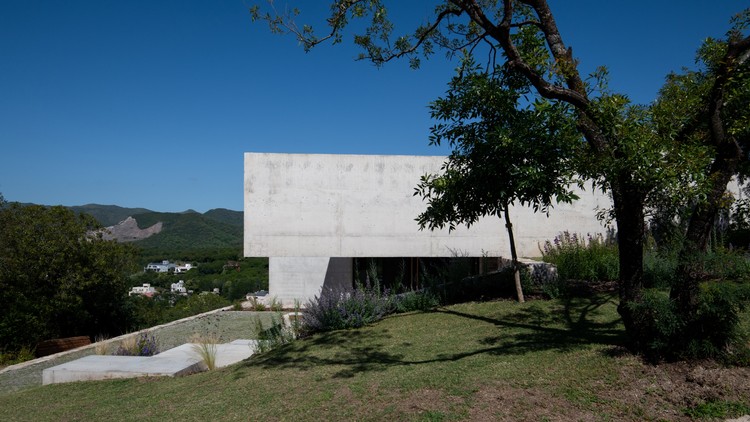Museum of the Fangshang Geopark BIAD
2014-04-09 01:00
“自然”这个词最基本的含义是双重的。在古希腊,“自然”是指万物生长和运动的内在特征。另一方面,“自然”被中国古代圣人视为一种“道”,内在地被包括人类在内的一切事物所追随,代表内在成长和发展的特征,而不是外在的强加。自然代表时间和空间的统一,它遵循自己的进化方式,享有持续的发展,并在自组织进化的基础上形成一个有机的整体。
The most basic meaning of the word “nature” is two-fold. In ancient Greece, “nature” referred to the inherent characteristics of growth and movement in everything. On the other hand, “nature” was regarded by ancient Chinese sages as a “Tao” intrinsically followed by everything, including humans, representing the characteristics grown and developed internally rather than being forced upon externally. Nature stands for the unity of time and space that, by following its own way of evolution, enjoys continuous development, and forms an organic whole based on self-organized evolution.
这是一个专门用来补充房山地质公园的博物馆,其主要目的是展示科技知识。作为设计的第一步,我们将博物馆定位为一座融入自然的建筑,以“创新的建筑理念”来表达自然美,并通过多样的建筑空间展现出自然的特色。
This is a museum specially intended for supplementing the Fangshan Geopark, and its main purpose is to exhibit science and technology knowledge. As our first step of designing, we positioned the museum as a building that should be integrated into nature, express natural beauty based on our “innovative architectural idea” and display natural characteristics through varied architectural space.
为了实现这一概念,我们进行了更大规模的调查,以确定“小建筑”与“大环境”之间的关系,并在设计时考虑到整个环境系统。我们创建了一个建筑,它看起来像一个建筑实体,一层向上爬,把破碎的地形连接成一个整体。博物馆的褶皱平面具有锯齿状的边缘,隐喻地描述了房山区复杂的地质变化,与远处的群山相呼应。以这种方式设计的建筑,不仅减少了土石方的工作量,而且还将破碎的地面修复成一个完整的整体。
To do the concept, we conducted investigations on a larger scale to identify the relations between “small building” and “large environment” and take the whole environmental system into consideration while designing the building. We created a building that looks like an architectural entity climbing upward layer by layer and links the broken terrain into a whole. The folded plane of the museum with jagged edges metaphorically describes the complex geological changes in Fangshan District and echoes the hills in the distance. The construction of a building designed in such a way not only minimized the amount of earthwork but also repaired the broken surface of the ground into a complete whole.
该建筑按功能划分为三个部分:展览馆、大厅、培训区和办公区。就功能而言,建筑物的体积也分为三个部分:南方有一个实体,北部有一个实体,中间有一个空实体。这个空的实体,就像一个三面戴着眼镜的水晶,就是大厅。
The building is divided into three parts according to its functions: exhibiting part, public hall, training and office area. The building bulk is also divided into three parts in terms of functions: there is a substantive entity in the south and the other in the north with an empty entity in between. The empty entity, like a crystal with glasses on its three sides, is the public hall.
我们在挑选建筑材料方面付出了很大的努力。我们希望这些材料能与博物馆的主题和周边环境相呼应。带着这样的希望,我们特别用石头作为所有功能空间的唯一建筑材料。石头的形成和劈裂,以及它们所代表的形状、质地和强烈的地方文化特征,都成为我们最初设计理念的起点。
We took great pains in selecting the building materials. It is our hope that the materials should echo the theme and the surrounding environment of the museum. With such a hope we specially use stones as the only building material for all the functional space. The formation and splitting of stones as well as their shape, texture and the strong local cultural features they represent all become the starting point of our original design conception.
 举报
举报
别默默的看了,快登录帮我评论一下吧!:)
注册
登录
更多评论
相关文章
-

描边风设计中,最容易犯的8种问题分析
2018年走过了四分之一,LOGO设计趋势也清晰了LOGO设计
-

描边风设计中,最容易犯的8种问题分析
2018年走过了四分之一,LOGO设计趋势也清晰了LOGO设计
-

描边风设计中,最容易犯的8种问题分析
2018年走过了四分之一,LOGO设计趋势也清晰了LOGO设计


















































































